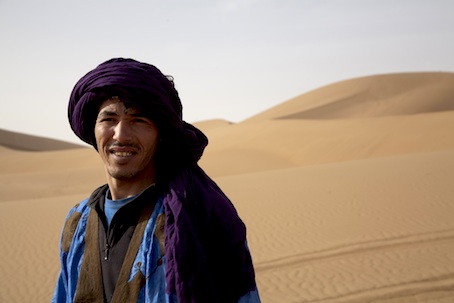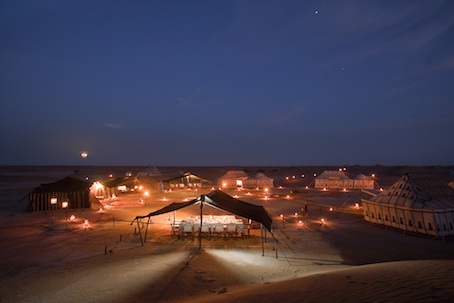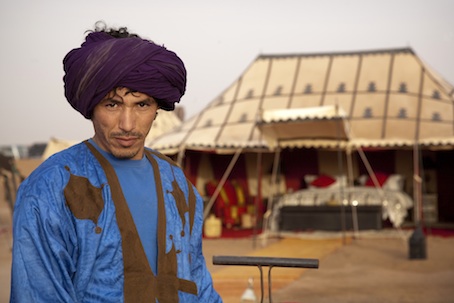Desert Rat
Resource collaborator and renowned intrepid reporter Giles Brown leaves the comforts of Southern Spain to find himself – in all senses – in the desolate dunes and far-off luxury of south-east Morocco
It was sitting on the sand dune, looking south over the endless sands of the Sahara, that I finally “got” why people come to the desert. From my sandy perch near Erg Chigaga, the largest dune in Morocco and only an hour from the south east border with Algeria, hundreds of smaller dunes stretched to the horizon and the silence was total. The only sound that I could hear was the blood pumping in my ears and my breathing, a little heavy after my climb up the newly-christened ‘Dune GB’.
“This is why people come to the desert,” I mused. “This is why so many of the great religions have periods in the wilderness mentioned. To find themselves. The solitude. The silence. To look deeply into themselves. Simply, as Hamlet would put it, ‘To be”.”
But then I paused from my revery, turned my baseball cap backwards on my head, adjusted my straps and with an ungainly bunny hop, thundered uncontrollably down the side of Dune GB on a snowboard. Dinner at camp was waiting and if was as good as lunch had been, I wanted to be on time.
I was on the edge of the Sahara as the guest of two old friends, Nick and Diane of Desert Camp Morocco. Both accomplished travellers, the couple had sold their hotel in Cape Town and were looking at setting up a Riad in Marrakech as a new adventure.
All that changed when Diane met Mohammed – whose nickname is Bobo – trekking in the Atlas Mountains. Originally from the village of M’hamid on the edge of the Sahara, Bobo told Diane about the dunes of Erg Chigaga and the backpacker camps in the area. Diane came back full of enthusiasm and decided that they should set up a luxury, upmarket camp in the desert.
You will, of course, be familiar with the old travellers’ adage that ‘getting there is half the fun’. Well with any trip that involves Morocco, getting there is all the fun. To describe the adventures that befell the photographer, Kevin, and myself on the first part of our journey would take an extra couple of articles. The shortened brief overview included: just avoiding a car crashing outside Algeciras; cancelled ferries in both Tarifa and Algeciras; torrential rain; catching the last ferry to Ceuta (it may have been 70 kilometres from Tangier and technically still in Spain, but at least it was North Africa); crossing the border into Morocco in scenes from a Terry Gilliam movie (and I’m sure there was some dung flinging involved); a truly terrifying 90-minute cab ride from Ceuta to Tangier, courtesy of the Maghreb’s answer to Fernando Alonso; rocking up to the Gare du Tanger to be told that the sleeping compartment had been derailed; and a 10-hour overnight train journey to Marrakech, in a ‘first-class’ compartment with no door or heating, while the teenager in the next compartment played Lady Gaga and French rap on her mobile in an endless loop.
It would be somewhat of an understatement to say that we were relived to arrive in Marrakech, although even that wasn’t without its problems. Events were unfolding in Cairo and Tunisia, and we had been warned to look out for riots and general unrest in the city. Although if you have ever driven through Marrakech, you’ll soon realise that general unrest is the normal order of things.
Our home for the night in Marrakech was the Zamzam Riad, located in the middle of the Medina and run by English couple Marcus and Emma. Named after a source of water that the Prophet Muhhamad found, the Zamzam really is an oasis away from the hustle and bustle of the medina, and very much like staying in the house of a particularly stylish Moroccan friend. The little details at the Zamzam make all the difference: a heated plunge pool, cosy library with fireplace, a rooftop spa with traditional Hammam and views over the Medina to the Minarets, which reminded me of a looking towards the Giralda; hardly a surprise as the Seville tower was modelled on Marrakech’s La Koutoubia.
With welcome pastries on arrival, superb atmospheric lighting, tastefully decorated rooms each with their own individual style, and a beautiful central courtyard with a large palm, Zamzam is very romantic. But, alas, I was sharing my twin room with Kev.
No stay in Marrakech would be complete without a guided tour of the Medina, and Zamzam arranged the excellent Ibrahim to show us around. For two hours he lead us through the maze-like streets, pointing out hidden gems such as the Museum Dar Bellarj, a private house once owned by a Swiss expat and now bequeathed to Marrakech as a women’s arts centre, and an artisan’s courtyard where he paused to feed his cats. Be warned: it’s an assault on the senses with noise, colour, bustle and an underlying faint smell of dung and urine. The Medina hasn’t changed that much since it was established in the 10th century, around the same time that William the Conquerer was preparing to invade England. You get the feeling that you are an extra in a Monty Python movie at every turn. We finished the tour at the famous Djamaa el Fna square, where Ibrahim left us with this pearl of wisdom: “You know the best thing about this 17-year-old hooker that is bringing down Berlusconi? She’s from Morocco!” he beamed proudly, and then wandered off into the teeming crowd.
Dinner that evening was at the Casino du Marrakech – if you fancy great food and a night at the tables I would recommend it (they filmed Sex and the City 2 in the adjacent hotel), but we had an early start the next morning and so Kev dragged me away before I could do myself too much damage in the poker room.
At five the next morning I was woken by the call from the minarets, calling the faithful to prayer. The crisp clear sound on the predawn air across the city stripped back the centuries, and I could have been standing in the Medina hundreds of years ago, was it not for the air-conditioned 4×4 waiting to take us to Chigaga.
The thought of a nine-hour drive south east of Marrakech might fill you full of dread (the same as driving from London to Glasgow, or Marbella to Barcelona) but that’s without factoring in the fantastic scenery that you encounter along the way. The journey to the camp is a location manager’s dream and takes you climbing up through the magnificent Atlas Mountains, where the villages dotted on the hillsides remind you strongly of the Spanish pueblos blancos, across the plateau that looks like something out of a Wild West movie and then down through the fertile Drâa Valley with its palms and kasbahs. We stopped over for lunch at the Dar Qamar, a guesthouse with a pool run by a French couple, where Brad Pitt and Cate Blanchett stayed when they filmed Babel nearby.
We then stopped to change from our air-conditioned 4×4 to a pick-up which was loaded up with supplies. Our driver introduce himself as Bobo’s brother and after a mint tea we were off into the desert. Half way through the trip we stopped for more mint tea in a café located in a dry lake. “I don’t speed over the lake,” he explained. “A couple of years ago four tourists were killed racing their jeeps across here when they touched and rolled.”
Soon we were among the dunes, skirting the hulking shape of Chigaga and then we pulled up at camp. It was spectacular. Rather than tents, our sleeping quarters were more like comfortable and stylish mini marquees, with an en-suite bathing tent (if you were wondering about such things, each bathing tent has an antique wash basin, ‘desert shower’ and hand painted chemical toilet).
And then we met Bobo – without doubt the coolest Berber on the planet – who greeted us in perfect English. If you were looking for a Berber version of Bob Marley, then Bobo would certainly fit the bill. An accomplished musician who has played gigs all over Europe, Bobo runs the camp with an efficient charm (a charm that was evident when he introduced us to his young Belgian girlfriend later in our stay…).
One of the things that had bothered me when I arrived at the camp was ‘what on Earth am I going to do?’ If you are looking for sedate activities then there is chess, backgammon and Scrabble, as well as a well stocked bar in the lounge tent. If you are feeling more energetic, then you can take a camel trek, head out to an oasis for lunch – the food at the camp is excellent, and there is plenty of it – go cross country 4×4-ing with Bobo or, as I did, try dune boarding.
But what you’ll find yourself doing at the camp most of all is just enjoying the feeling of being in a totally different environment. That night I sat by an open fire, eating a tasty tagine and bread that had been cooked in the sand by Bobo’s cousin, while Bobo sang and drummed by candle light. The stars hung impossibly large over my head and the moon was incredibly bright. And when I went for a silent moonlit walk back to ‘my’ dune later that evening, I wouldn’t – and couldn’t – have been anywhere else in the world.
+DETAILS
www.riadzamzam.com
www.desertcampmorocco.com
Photographs: © www.khphotography.co.uk







http://www.khphotography.co.uk/morocco.html
and here is a whole lot more photos, great trip to make and a great place to be.
Thanks Kev. The photographs are beautiful.
Great article, Giles, lovely pics, Kevin, un abrazo, Vincent